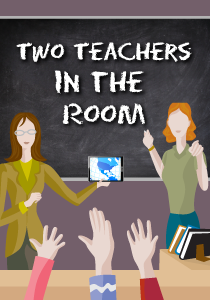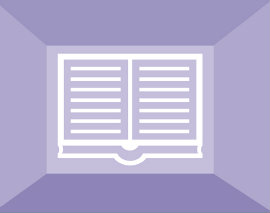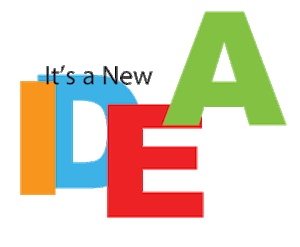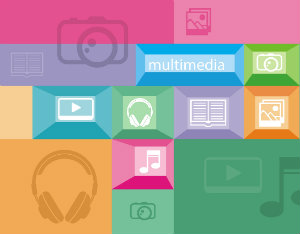What Should a Co-Taught Curriculum Look Like?
A MiddleWeb Blog
 There are many, many frequently asked questions when it comes to co-teaching. This post will be devoted to one that I hear so often it deserves a post of its own.
There are many, many frequently asked questions when it comes to co-teaching. This post will be devoted to one that I hear so often it deserves a post of its own.
It was brought to the forefront again for me last Tuesday (9/22/15) when it was the hot topic question at our most recent #coteachat. It was “You Ask the Questions” night, and my colleagues Johnny Cataffo (@JMCataffo) and Christie Flayhart (@FlayhartC) facilitated a lively round of Twitter discussion.
In my humble opionion, the #1 top FAQ that co-teachers have is this:
Should the curriculum in a co-teaching classroom setting look different from a typical general education classroom?
I must admit I’ve had to make a conscious effort not to just blurt out my heartfelt response here and call it a post. No. I must give my response the time it deserves. Because the learners in these co-taught classrooms deserve a more thorough explanation that will go far and wide – near and far – and at least some extra inches deep!
The Many Layered Response
Let’s begin with a brief history of special education just to set the tone and context for how far our educational system has come about. Unlike earlier decades, our children are now all educated together – same buildings – same classrooms – the way it should be. We have the opportunities to create meaningful learning experiences with all learners respecting the individual talents and abilities that are present in all variable learners everywhere.

So if we share our undying belief in our students with our students and then provide the opportunities for them to personally connect to the lessons (lots of individualized support and scaffolding, as needed), well, then that would just be the ideal world.
But is it possible in the real world? Let’s take a look at the Application to Students with Disabilities document, for example. This document can be found in the resources section at the website of the Common Core State Standards Initiative.
The first two paragraphs of this document are completely empowering! I mean seriously! Here, take a look…
The Common Core State Standards articulate rigorous grade-level expectations in the areas of mathematics and English language arts. These standards identify the knowledge and skills students need in order to be successful in college and careers.

The continued development of understanding about research-based instructional practices and a focus on their effective implementation will help improve access to mathematics and English language arts (ELA) standards for all students, including those with disabilities.
Anyone who has been in the field of special education for awhile knows what I mean when I talk about history. Before the public laws to protect the rights of all learners, far too many people did not assume competence when it came to believing and knowing what students with disabilities could accomplish. Beyond inexcusable and sad, I know.
When we think about the history…the fact that students with disabilities were often ostracized – educated in the basement of their schools – or not permitted to enter public school classrooms at all, I shudder to just type these woeful realities of the past.
But we’ve come a long way

Educators are becoming savvy about applying a variety of techniques and strategies to scaffold and support the learning process and to provide opportunities for each learner to achieve to his or her personal best. And co-teachers have the opportunity handed to them on a silver platter! C’mon!
Two teachers in the room means we have more time and resources to make it all happen. It means we can shake it up a bit! Use the expertise and resources from both teachers to create a meaningful process that guides all learners to move toward the same high expectations and learning objectives as any other classroom.
And it is completely doable! It’s all about the teachers knowing the present levels of performance in each student and then moving forward from there.
Collaboration is key – What two can do
With two teachers in the room, this task is simply a matter of both teachers collaborating to make it happen. And it is also about all grade level teachers collaborating to have a shared vision of what is expected at each grade level.
The next step is for the two co-teachers to take that information and plan for what that will look like in their room. Flexibility and resourcefulness are the keys!
The CCSS Applications for Students with Disabilities document supports this flexibility for co-teachers:
In order for students with disabilities to meet high academic standards and to fully demonstrate their conceptual and procedural knowledge and skills in mathematics, reading, writing, speaking and listening (English language arts), their instruction must incorporate supports and accommodations, including:
- Supports and related services designed to meet the unique needs of these students and to enable their access to the general education curriculum (IDEA 34 CFR §300.34, 2004). • An Individualized Education Program (IEP)1 which includes annual goals aligned with and chosen to facilitate their attainment of grade-level academic standards.
- Teachers and specialized instructional support personnel who are prepared and qualified to deliver high-quality, evidence-based, individualized instruction and support services.
Promoting a culture of high expectations for all students is a fundamental goal of the Common Core State Standards. In order to participate with success in the general curriculum, students with disabilities, as appropriate, may be provided additional supports and services, such as:
- Instructional supports for learning – based on the principles of Universal Design for Learning (UDL)2 – which foster student engagement by presenting information in multiple ways and allowing for diverse avenues of action and expression.
So, be flexible—and go have some creative fun, folks! Yes, keep the same high expectations for all—but who says the process must look the same in all classrooms?
And speaking about UDL…

The Common Core Standards and curriculum should be seen as guidelines to keeping high expectations for all. But no one anywhere is telling you HOW to make this happen in your classroom. And the UDL Guidelines 2.0 graphic organizer is one powerful tool to guide your collaborations and instructional decisions.
So here we are with my top co-teaching FAQ of the month…
Should the curriculum in a co-teaching classroom setting look different from a typical general education classroom?
What do YOU think?
What are other FAQ’s you would like to see answered here at Two Teachers in the Room?
Looking forward to our conversations and action plans!


































This is an amazing article and very timely as I continue to share with staff best practices. I commend you on articulating such an intentional scope of instruction in co-teaching.
Love this article! I was one of the teachers on the recent co-teach chat. In Texas we do not use Common Core — but we have the same commitment to rigor and college readiness in our TEKS. The trick is always about the scaffolds and supports to make that curriculum accessible. Which may mean using data to see where the learning gaps are for students and then finding ways to close those gaps. Sometimes this may involve teaching the same skills/learning objectives but using a more accessible text, or by embracing the supports that student(s) need in the class. I think the key is using the collaborative teaching model to make sure that as lessons are planned — all student needs are addressed. (pre-planning the type and timing of needed scaffolds and supports).
Loved this article and I agree whole-heartedly. I am currently teaching in an amazing co-teaching partnership and we have found so much success through high expectations and that fun, creative environment you describe!